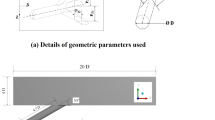Abstract
In order to investigate the double-reverse-jet film cooling (DRJFC), the multi-field coupling calculating method is used to study the effect of geometric parameters on the resultant vortex structure and conjugate thermal-elastic property. The traditional streamwise film cooling is also investigated for comparison. The results indicate that the formation of effective anti-kidney vortices is the key to enhance the dimensionless temperature of DRJFC holes. At low blowing ratios, the streamwise or lateral distance between two DRJFC holes should be increased to widen the transverse shift of the jets, thus, to increase the cooling performance. At high blowing ratios, the lateral distance should be decreased to prevent two jets from separating apart so that the malfunction of the anti-kidney vortices could be avoided. The stress concentration resulting from the nonuniform temperature distribution is considered.
Similar content being viewed by others
References
J. C. Han, S. Dutta, and S. Ekkad, Gas Turbine Heat Transfer and Cooling Technology (Taylor and Francis, London, 2000).
E. P. Volchkov, S. S. Kutateladze, and A. I. Leont’ev, “Effect of Compressibility and Nonisothermicity on the Efficiency of Film Cooling in a Turbulent Boundary Layer”, Prikl. Mekli. Tekli. Fiz. 7 (4), 126–129 (1966 [J. Appl. Mech. Tech. Phys. 7 (4), 93–94 (1966].
E. P. Volchkov and V. Ya. Levchenko, “Effectiveness of Gas Film Cooling for a Turbulent Boundary Layer”, Prikl. Mekh. Tekh. Fiz. 6 (5), 142–146 (1965 [J. Appl. Mech. Tech. Phys.} 6 (5), 100–102 (1965].
C. Zhang and Z. Wang, “Effect of the Downstream Crescent-Shaped Block Height on the Flat-Plate Film Flow and Cooling Performance”, Prikl. Mekh. Tekh. Fiz. 59 (5), 213–222 (2018 [J. Appl. Mech. Tech. Phys. 59 (5), 951–961 (2018].
K. Kusterer, D. Bohn, T. Sugimoto, et al., “Double-Jet Ejection of Cooling Air for Improved Film-Cooling”, ASME Paper No. GT-2006-90854 (2006).
K. Kusterer, A. Elyas, D. Bohn, et al., “Double-Jet Film-Cooling for Highly Efficient Film-Cooling with Low Blowing Ratios”, ASME Paper No. GT-2008-50073 (2008).
K. Kusterer, D. Bohn, T. Sugimoto, et al., “Influence of Blowing Ratio on the Double-Jet Ejection of Cooling Air”, ASME Paper No. GT-2007-27301 (2007).
Z. Wang, J. Liu, B. An, et al., “Effects of Axial Row-Spacing for Double-Jet Film-Cooling on the Dimensionless Temperature”, ASME Paper No. GT2011-46055 (2011).
L. Graf and L. Kleiser, “Large-Eddy Simulation of Double-Row Compound-Angle Film Cooling: Setup and Validation”, Comput. Fluids 43, 58–67 (2011).
B. Farzad and P. Pegah, “Film Cooling Flow by Double Rows of Compound Angle and Compound Angle Shaped Holes”, ASME Paper No. GT2013-95272 (2013).
G. Liao, X. Wang, J. Li, et al., “Effects of Curvature on the Film Dimensionless Temperature of Double-Jet Film Cooling”, ASME Paper No. GT2014-26263 (2014).
Z. Wang, C. Zhang, and J. J. Liu, “Thermal-Elastic Coupling Analysis of Round-Hole Flat-Plate Film-Cooling”, J. Aerospace Power 30, 1298–1306 (2015).
Z. Wang, C. Zhang, Y. Chen, et al., “Study on Thermo-Elastic Coupling Characteristics of Dual-Row Film Cooling”, J. Propuls. Technol. 38, 2038–2045 (2017).
F. Z. Sierra, C. Bolaina, J. Kubiak, et al., “Heat Transfer and Thermal Mechanical Stress Distributions in Gas Turbine Blades”, ASME Paper No. GT2009-59194 (2009).
G. Nowak and W. Wroblewski, “Thermal Mechanical Optimization of Cooled Turbine Blade”, ASME Paper No. GT2007-28196 (2007).
S. Amaral, T. Verstraete, R. V. Braembussche, et al., “Design and Optimization of the Internal Cooling Channels of a HP Turbine Blade. Pt 1. Methodology”, ASME Paper No. GT2008-51077 (2008).
Author information
Authors and Affiliations
Corresponding authors
Additional information
Original Russian Text © Z. Wang, C. Zhang, S.-J. Li, J.-J. Liu, H.-W. Zhang.
__________
Translated from Prikladnaya Mekhanika i Tekhnicheskaya Fizika, Vol. 60, No. 6, pp. 97–106, November-December, 2019.
Rights and permissions
About this article
Cite this article
Wang, Z., Zhang, C., Li, SJ. et al. Effects of Geometry Parameters on the Cooling Performance and Conjugate Thermal-Elastic Property of Double-Reverse-Jet Film Cooling. J Appl Mech Tech Phy 60, 1060–1067 (2019). https://doi.org/10.1134/S0021894419060117
Received:
Revised:
Accepted:
Published:
Issue Date:
DOI: https://doi.org/10.1134/S0021894419060117



